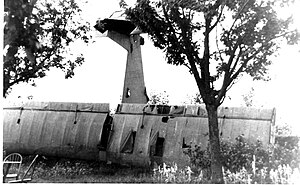
The Cessna 188 is a family of light agricultural aircraft produced between 1966 and 1983 by the Cessna Aircraft Company.

The Caudron C.60 was a French two-seat biplane of the 1920s and 1930s with a single engine and a canvas-covered fuselage. The French aircraft manufacturer Caudron developed this aircraft from the Caudron C.59. It was mainly used as a trainer aircraft.
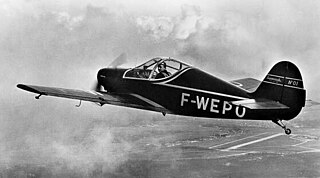
The CAB GY-30 Supercab was a two-seat light aircraft built in France in 1954, as a further development of the CAB Minicab. The design was performed by Yves Gardan, a onetime employee of French aeronautical company SIPA. Changes incorporated in the Supercab included a more powerful engine, greater wingspan, manually retractable undercarriage, and slotted flaps that replaced the split flaps of the Minicab.
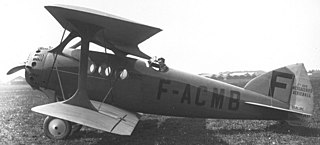
The Bleriot-SPAD S.33 was a small French airliner developed soon after World War I. The aircraft was a biplane of conventional configuration whose design owed much to the Blériot company's contemporary fighter designs such as the S.20. Four passengers could be accommodated in an enclosed cabin within the monocoque fuselage, and a fifth passenger could ride in the open cockpit beside the pilot. A great success, the S.33 dominated its field throughout the 1920s, initially on CMA's Paris-London route, and later on continental routes serviced by Franco-Roumaine.
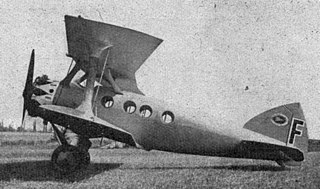
The Blériot-SPAD S.56 was a family of French airliners developed in the 1920s as various refinements of the S.33 design. All S.56 versions shared two new features: the first was a newly designed, all-metal wing, replacing the wooden wing of earlier related designs and the second was a redesigned passenger cabin, replacing the S.33's four single seats in a row with two rows of double seats. A second access door was also added.
The Blériot-SPAD S.81 was a French fighter aircraft developed in 1923 to a requirement by the French Air Force. It was flown competitively against the Dewoitine D.1 and was selected over that aircraft due to the Dewoitine's more radical design, leading to an order for 80 aircraft. The S.81 was a single-bay biplane of conventional configuration with I-shaped interplane struts and lacking Herbemont's usual swept upper wing. It featured a wooden fuselage of monocoque construction and metal wings skinned in fabric. Production versions differed from the prototypes in having a lengthened fuselage and larger tail fin.

The Caudron C.109 was a light utility aircraft built in France in the late 1920s.

The Farman F.200 was a civil utility aircraft produced in France in the 1930s. Derived from the F.190, it featured a revised fuselage that did away with its predecessor's enclosed cabin. Instead, it was a parasol-wing monoplane with open cockpits in tandem for the pilot and one or two passengers. Intended primarily as a trainer, it was also marketed as being suitable as a photographic platform or a mail plane.
The Lefebvre MP.205 Busard was a single-seat racing aircraft built in France in 1975 and marketed for homebuilding. Its design was adapted from that of the Lefebvre MP-204 'Busard' racer, that had been conceived to attempt a world airspeed record in the under 500 kg class in 1949. Compared to its predecessor, the Busard was lightened and intended to be powered by a lower-power engine, and simplified for construction by amateurs. Indeed, the prototype was built by the designer with assistance from students at the Albert Camus technical school of Rouen. Like the MP.204 that it was based on, the Busard was a streamlined, low-wing, cantilever monoplane of conventional design with fixed, tricycle undercarriage. Provision was made for the use of either an aero engine, or a Volkswagen automotive engine.
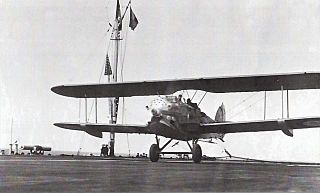
The Levasseur PL.4, aka Levasseur Marin, was a carrier-based reconnaissance aircraft produced in France in the 1920s.

The Levasseur PL.6 C.2, also known as Levasseur VI C.2, was a two-seat fighter aircraft built in France in 1926 in order to meet a 1925 C.2 Service Technique de l'Aéronautique (STAé) specification,. Constructed along the same lines as Levasseur's naval aircraft of the same era, it was a conventional, single-bay biplane with seating for the pilot and tail gunner in separate, open cockpits. Flight testing of the prototype commenced in 1926, and it was exhibited at the Salon de l'Aéronautique at the end of the year.

The Leopoldoff Colibri is a French-built light sporting and trainer biplane of the 1930s.

The SPAD XIV was a French biplane floatplane fighter aircraft built by Société Pour L'Aviation et ses Dérivés (SPAD) and flown by the French Navy during World War I.

The Eagle DW.1 is an American-built single-seat agricultural biplane of the late 1970s.

The Ambrosini Rondone is an Italian-designed two/three-seat light touring monoplane of the early 1950s.
The Larsen Special II, is an early homebuilt aircraft that was designed and built in Norway. It was the first homebuilt aircraft to be issued a certificate of airworthiness in Norway.

The Caudron C.161 was a lightweight French two-seat biplane designed by Caudron for sport or flight training use. A conventional biplane with a square fuselage powered by a 65 hp (48 kW) Salmson radial engine. It had two cockpits in tandem with dual controls in both, when not used as a trainer the controls could be removed from the rear cockpit. A variant, the C.168, with a more powerful 70 hp (52 kW) Anzani radial engine was also available.
The Anglin J6 Karatoo is an Australian ultralight and light-sport aircraft that was designed by Jesse Anglin and introduced in 1982. Over the years the J6 Karatoo has been produced by several different manufacturers, including Amax Engineering of Donvale, Victoria, Skyway Aircraft and is currently built by Serenity Aviation of Australia. The aircraft is supplied as plans or as a kit for amateur construction.
The Poulin JP.20 Globe Trotter was a two-seat, high-wing monoplane touring aircraft built in France in the early 1950s.
The Chatelain AC.9 is a 1960s French two-seat homebuilt aircraft designed by Armand Chatelain.
